It's the half dark before dawn and we're on an abandoned farm in south Tipperary trying to blend in. "This is all the way from America," John Lalor whispers spritzing our clothes with scent eliminator to hide our human hum. He's not convinced of its merits but we're going the whole hog. It's called Fall Blend and smells like damp leaves. More importantly I haven't showered this morning as per John's instructions: no creams, no perfume, no deodorant that could be carried on the wind to twitching noses.
John pulls a green camouflaged buff up over his face so only his eyes are showing. We do the same, with buffs from a new pack of three from Sweden. We won't need the white one for snow. It's already a good five degrees out.
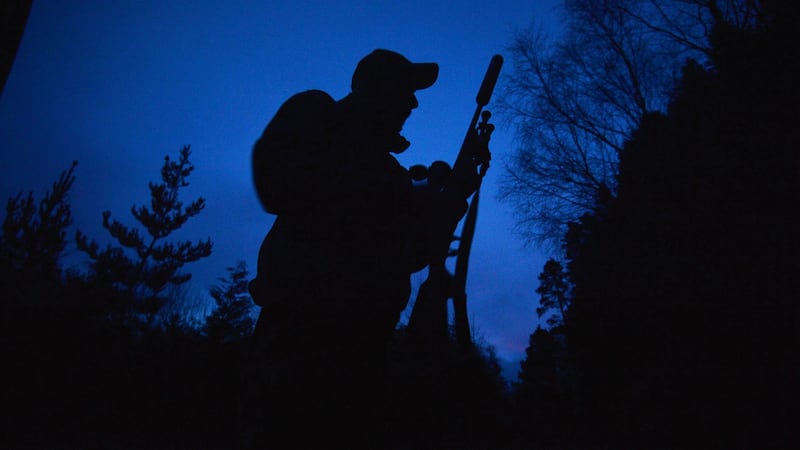
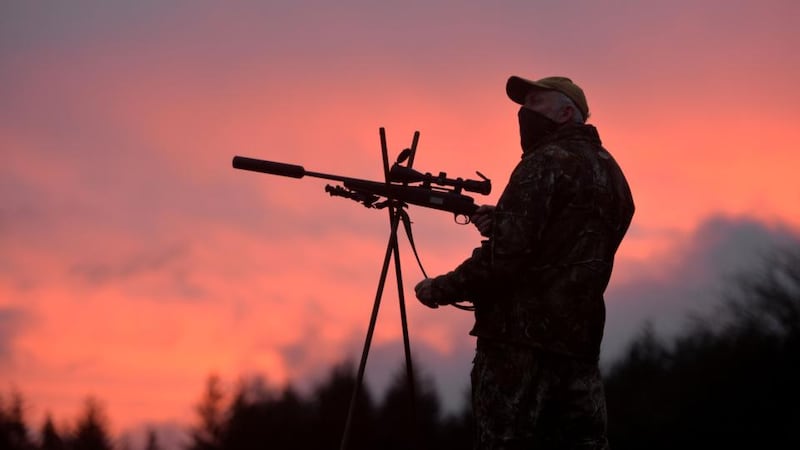
We’re going on a deer hunt. We have talked in whispers in the jeep and closed the doors as softly as possible to try to maintain the quiet of this remote spot in the Tipperary countryside. The only sounds are the click-clack as John loads four bullets into his high velocity rifle and the quieter click of photographer Alan Betson’s camera shutter. These human sounds are hard-edged against the birdsong and breeze. Then John shoulders the rifle, tucks his shooting stick under his left arm and we head off down the dark lane to witness the visceral truth behind a plate of venison. Maybe. If a deer runs out of luck this morning.
There are just over two weeks left in the season so we are only allowed to shoot females and antlerless bucks. This puts Bambi and Bambi's mother in the crosshairs
Not many of us are as connected to our food as John Lalor. The 61-year-old retired school principal first went out with his father Eoin to hunt at the age of four. His father died when he was 12. His grown-up son Shane (named after the 1953 Alan Ladd western) is his regular hunting partner. John eats what he kills, butchering the deer in his garage and kitchen and freezing or bartering the meat. At the end of deer season he puts away his guns and takes out his fly rod. One friend sews up the barbed wire snags in his hunting clothes in return for some deer meat. "She fixes your crotch for you," his neighbour teases him later when we sit down to a Jamie Oliver venison stew.
Human heart
If meat is murder I’ve only ever been an accessory after the event, helping to dispose of the body, and happy to do so when the animal has lived a good life. I’ve seen living creatures turned into cold carcasses: chickens plucked, their bodies still warm and heavy on your lap. I’ve smelled the spill and slither of innards, the messy stuff that goes with the making of meat. But this is bigger. I have nothing but fear and loathing for guns. And an adult deer has a heart roughly the same size as mine. There are just over two weeks left in the season so today we are only allowed to shoot females and antlerless bucks. This puts Bambi and Bambi’s mother in the crosshairs. As a meat eater it doesn’t get more real.
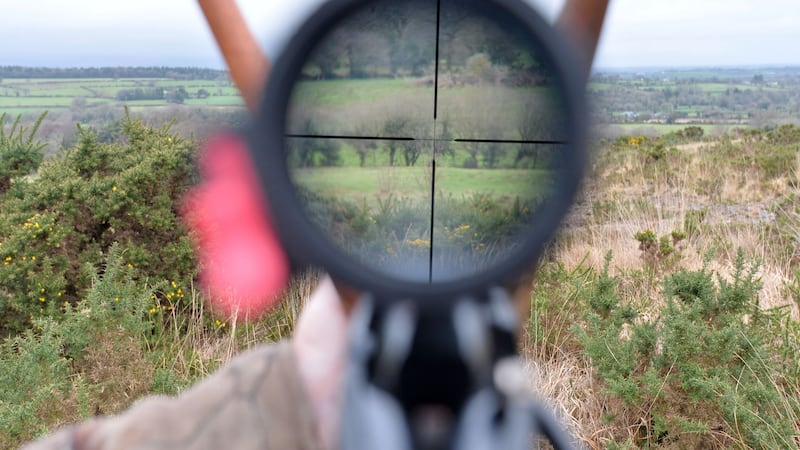
The only thing that stands out against his camouflaged hunting clothes and wellies is his rifle, a long, black American Marlin. Holding it to let him duck under a barbed wire fence, it feels surprisingly heavy, the barrel cold to the touch. It’s a hard black material. “Synthetic is a more modern thing. It won’t be affected by the wind and rain, the wood won’t swell,” he says. Swollen timber puts the sights off and a rifle is only as good as its sights.
His gun is licensed every three years. His application needs two referees and the name of his doctor. “You also have to be a member of a gun club and get written permission from the farmer whose land you are going to shoot on.” For deer hunting he also needs a licence from the National Parks and Wildlife Service.
"We might get [a deer] today if we're lucky," he says. But nothing is guaranteed. "That's why it's called hunting not killing." A poacher could go out at night and dazzle the deer with headlights (they stand stunned in bright light) but this is a hunt not a slaughter. He has seen Facebook posts about poachers getting 10-18 deer a night. With an average carcass having 30 kilos of meat, at about €2 a kilo it's roughly €60 per animal. During the recession he thinks the population of fallow deer fell as people turned to hunting and poaching to make money.
Anyone who plays sport knows that if you score a goal or a point or a try or whatever you're on a high. It's the same as anything. It's a sport
The hunt begins at with a sense of calm urgency and just the snap of twigs underfoot and the squelch of mud. The first hour is usually the best time. We stick close to the fences and hedges. John beckons with his hand to huddle closer and whisper the next move. “Try and keep the light towards you,” he whispers spotting the red glow on my recorder. “They’ll see it.”
It’s an intense way to be outdoors. A Swedish friend who has hunted described it as a hyper-alert state. You see, smell and hear things differently, she said. Hunters are deeply in the countryside in a way that we who experience it through a car window can only imagine.
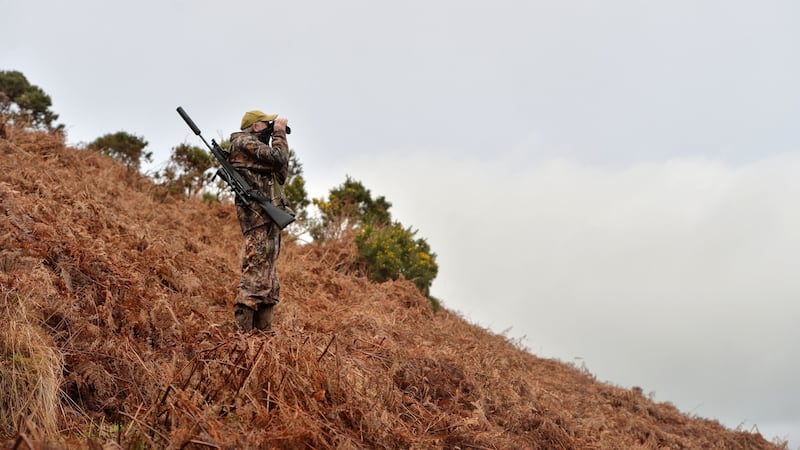
Fallow deer
The "they" who might see my light are the fallow deer who live in this area. John saw about 40 of them here on a scout a few days earlier. But we're at the difficult end of the season. They've been "hunted hard" since October and have learned a thing or two about people like us. "The stupid deer are all dead by now," he says. I picture a herd of Gary Larson deer in armchairs barely glancing up from their newspapers as we creep clumsily by.
John knows these lanes, ditches, copses and fields like I know the aisles of my local supermarket. He points out a deer track where the animals have crossed and broken through briars. There's a deer crossroads and another path he calls the M50 of deer. At one point there's a crash and flutter from the trees. "The pigeons see us from the trees and they fly out and that frightens the deer," he whispers. "The worst of the lot is a cock pheasant. He upsets everything." With the end of his shooting stick (two long sticks tied together that he uses to balance the rifle) he points to fresh tracks, small cloven hooves beside larger ones that indicate a fawn with a doe.
What is the thrill for the hunter? "Anyone who plays sport knows that if you score a goal or a point or a try or whatever you're on a high. You're pumped up with adrenalin. It's the same as anything. It's a sport," John says. "I've taken [a rugby player], I won't mention any names, but he was playing for Ireland last Saturday. He shot his first black fallow stag with me out here. He was thrilled." John doesn't charge for a hunt. This was done through a mutual friend but a four-day stalk in Wicklow could cost more than €2,000, he says. "Just because you paid somebody a lot of money doesn't mean you get something."
"If one of these bullets hits a human that's it. It's a high-velocity round. It basically turns into a mushroom. If it hits you in the arm, you'd probably bleed to death
The fallow deer here feed on grass mainly. In summer they love crab apples and barley or corn. Later Shane shows us a drone shot of a golden field in the summer with deer tracks running through it like cracks in the combed surface. As the drone skims the field, a stag in the middle breaks into a gallop out and along the hedge.
Food fictions
John believes we prefer to gloss over the details of how food gets to our tables. "Milk doesn't come from a cow it comes from a carton. Nothing to do with the cow at all. Sausages don't come from a pig. You get them in a supermarket and they're all nicely wrapped up in polythene and no poor pig had to die. Maybe they're the facts of modern-day life. I think in a way we've lost contact with rural Ireland or rural life." The venison he eats is low in fat and antibiotic-free. "It's pure organic. There's very little fat on it. If you go fishing you get your omega three factor. If I do ever have a heart attack I might get good care in the coronary care unit in Clonmel where my better half is working." John's wife, Maria, is on a 13-hour shift there today. So she's saving lives while you're shooting deer? "I might be saving people from going into her as well, keeping their cholesterol down," he says. "There's two sides to every story."
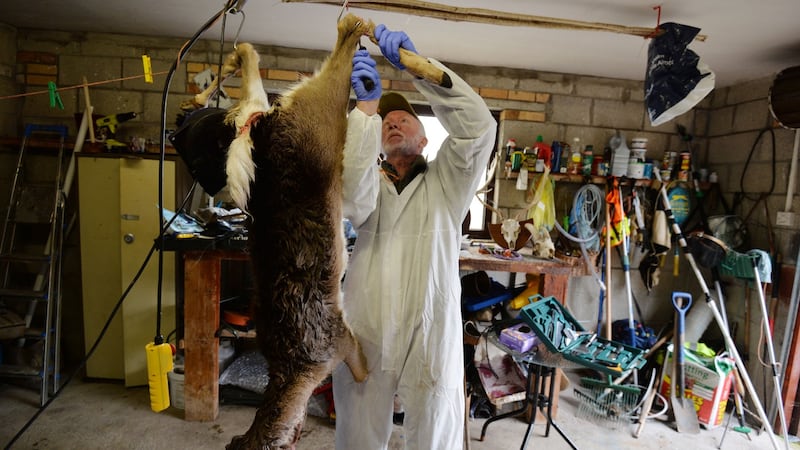
The hunt is a good workout. We go down a steep vee that finishes with a scramble over a barbed and sheep wire fence at the top. John calls it Hell’s Canyon because if you shoot a deer at the bottom of it, it’s a hell of a job to pull it back out back to the jeep.
What would he say to people who find the idea of shooting a wild deer abhorrent? “In Ireland deer have no predator. There’s no wolves anymore, no bears. They don’t suffer starvation because of weather. There’s only one predator to control them,” he says meaning the human hunter. “Without that, the population would explode and they could become emaciated and die of starvation or cause massive damage to farmers and forestry.”
Deer can be a hazard on roads, he says. They kill young trees by thrashing their antlers along the branches to scratch off the velvet as the antlers grow. In summer when deer season is suspended farmers can apply for a permit to cull deer causing damage to crops.
Hunting is also about conservation, he says. Later he'll show us a duck sanctuary in woodland set up by the Ardfinnan, Ballybacon, Grange and Newcastle Gun Club. No one is allowed to bring a gun in here. The ducks are tame enough to waddle after some children looking for more food when we arrive.
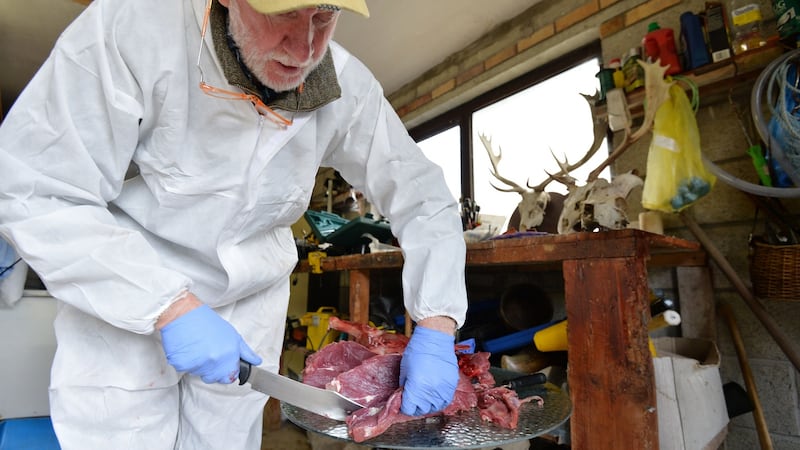
After three hours hunting we have seen every sign of deer but haven’t had a sighting. We have caught nothing but a “wild kind of sunrise” a huge wash of salmon pink across the sky. A last sweep of a boggy field where they might be bedded down shows up nothing. It’s too warm, John thinks. In colder weather they would break cover to go and graze.
High-velocity bullet
We talk about the gun. The safest assumption to make is that you’re going to miss, John says, that way you plan for where your bullet is going to end up after you miss. “If one of these bullets hits a human that’s it. It’s a high-velocity round. It basically turns into a mushroom. It makes an awful hole. If it hits you there [he indicates his chest] it’ll make an awful hole. If it hits you in the arm, you’d probably bleed to death.”
If you live a bad life you're gonna come back as a deer and depending on how bad you've lived your life some fella's gonna shoot you in the arse
We finish with a plywood deer target set up just over 100m from us in a sloping field and Shane’s rifle with its sniper sights on his tripod so we can take a shot. The crosshairs wobble, even though I’m bracing the rifle against my shoulder and standing statue-still. My breathing is causing the tremor. Before squeezing the trigger I have to breathe in slowly and then stop and hold it mid-breath on the exhale. Even with the silencer on the barrel the sound is shattering. John takes off his silencer to demonstrate the blast of one ear-ringing shot. But it is more than just sound. The crack seems to tear open the air, splitting the day in two, the bullet travelling so fast that it has hit the target before I’ve stopped squeezing the trigger. Through the binoculars Shane can see that I’ve made a kill shot on my first attempt, thanks to some sophisticated gun sights. Could I aim the crosshairs on an animal? I don’t think so.
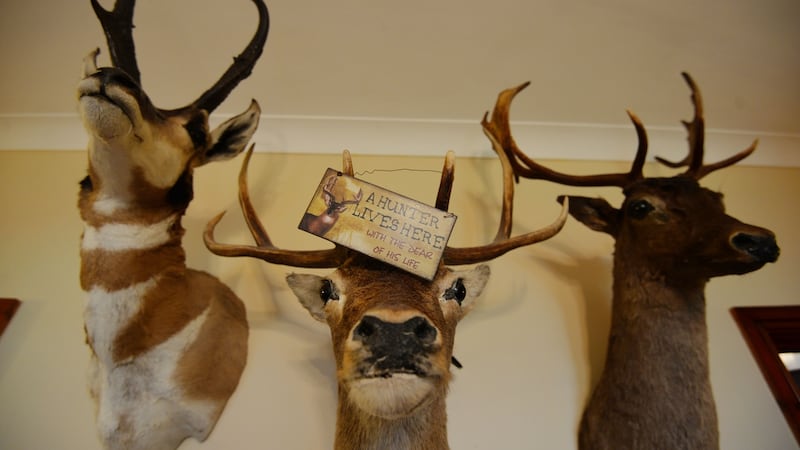
I might be one of those hunters who gets “buck fever”, a trembling panic that sets in when they take aim. A miss can shatter confidence making the next shot harder.
“It might sound strange but sometimes the bullet goes through the heart and they just stand there. They’re dead but just things haven’t shut down. It’s so instantaneous. The bullet that frightens the deer the most is the one that misses,” John explains back at his garage as he shows us the carcass of a deer shot a few days earlier. The bullet has gone through the rib cage, a finger-sized hole in one side, the larger exit wound on the other. The guts, blood and stomach of the animal are left at the site of the kill, he explains, in a process called gralloching. Crows and foxes make short work of the debris. Then he removes the heart, kidneys, liver and lungs back at the garage before skinning and hanging the animals for up to nine days. He checks the organs for signs of disease. the best meat is found along the back bone, the fillet cuts which he cuts into steaks. Haunches get minced for burger meat or cut into chunks for stewing.
Venison stew
All of which brings us to John's neighbours Mary and Arthur O'Donnell's dinner table for a late lunch, Their son Risteárd is the award-winning documentary maker behind the film Atlantic. Mary has made a delicious venison stew with some meat that John gave her using a Jamie Oliver recipe that called for juniper berries. Arthur threw in some frozen gooseberries from their garden. The vegetables are all home-grown. The table is beautifully laid for the feast but Mary's not tucking in like the rest of us. "I don't eat venison," she says smiling at John. "I can't bear to think about the poor little Bambi."
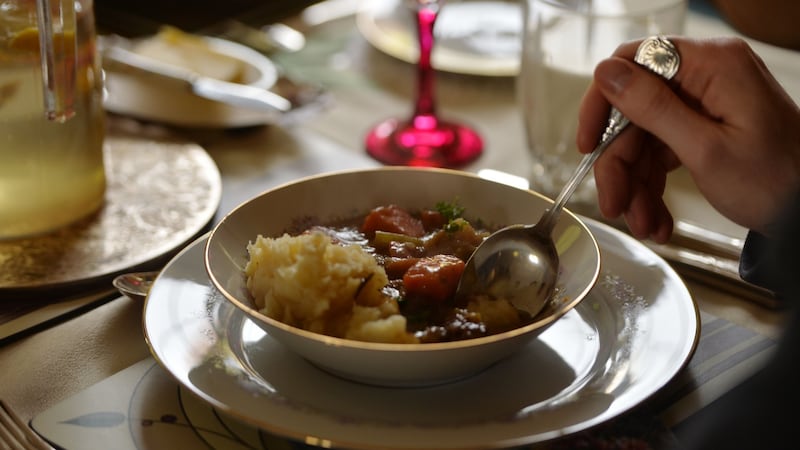
John drives us back to the Kilcoran Lodge, a former hunting lodge bedecked with stuffed deer and hunting pictures. Does seeing animals die makes him think about his own mortality? He recently helped an older hunter with a deer. “He was 85, 24 years older than me. I’d rather die of a heart attack up on that hill than in an old folks home.”
As a school teacher, he has taught religion all his life. “When animals die I don’t think there’s any place for them,” he says. “I don’t know where you go. It depends on what you believe in.” And what if you come back as a deer? “That’s the joke I have with my friends. I say to them if you live a bad life you’re gonna come back as a deer and depending on how bad you’ve lived your life some fella’s gonna shoot you in the arse, or not right and you’re gonna be running around the side of the mountain. What you believe in is what the Indians say: the happy hunting ground.”
Hunting on the Northern Trails: An Irish Man's Shooting Stories from the Rocky Mountains to Swedish Lapland, by John Lalor is available in book, hunting and fishing shops













